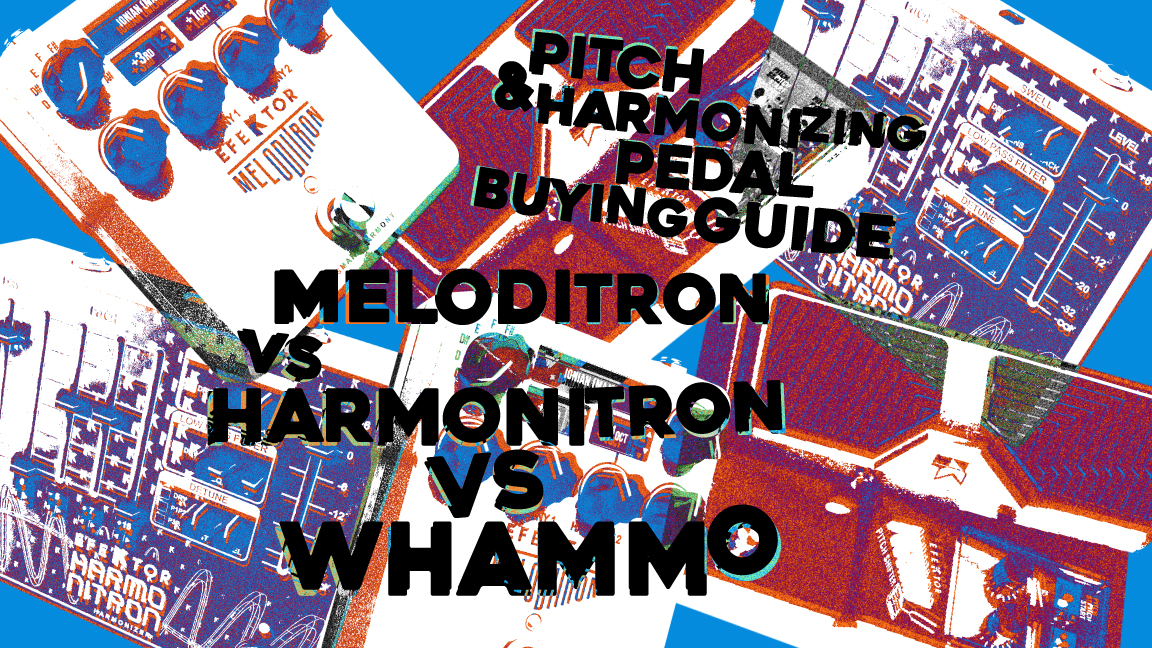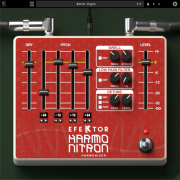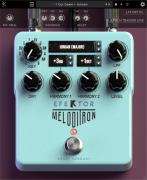
When it comes to guitar effects, the world of pitch and harmony modulation has opened up new avenues for unorthodox guitarists and those with experimental inclinations. Kuassa, a leading developer in the realm of guitar VST effects, has been at the forefront of crafting algorithms that delve into the nuances of pitch and harmony, delivering exceptional sound quality to stand out in this evolving field.
Pitch and harmony effects for guitar pedals represent a relatively new realm compared to the more established overdrive and fuzz effects. These effects, often regarded as primary tools for unconventional guitarists, have the potential to introduce experimental and abstract sonic dimensions depending on the player’s style.
Pitch-shifting guitar pedals are effects units capable of altering the pitch of a guitar signal. Unlike conventional octave effects, they can shift the pitch by any chosen interval, expanding the sonic palette considerably. This enables guitarists to create a diverse array of sounds, from emulating alternate tunings to reaching notes beyond their instrument’s natural range. In the contemporary landscape, these effects are predominantly digital, leveraging digital signal processing (DSP) to achieve accurate and versatile pitch shifting. Not many guitar VST effects developers can craft these algorithms with Kuassa being one of the best in nailing the sound.
Monophonic vs Polyphonic?
Pitch-shifting pedals come in two fundamental tracking types: monophonic and polyphonic. Monophonic pedals can track a single note at a time, whereas polyphonic pedals can handle multiple notes simultaneously, making them better suited for chords and harmonies.
Monophonic effects, as the name suggests, focus on individual notes. Such effects track and manipulate one note at a time, which means that when you play a chord, only the highest or most recent note gets processed. This approach is ideal for lead guitar lines and melodies where notes are played sequentially. On the other hand, polyphonic effects work harmoniously with chords and multiple notes. These effects have the ability to process and manipulate several notes simultaneously.
Kuassa’s Pitch-Shifting Arsenal: Whammo, Harmonitron, and Meloditron
Kuassa introduces a trio of pitch pedals: Whammo, Harmonitron, and Meloditron. Each have their own methods and algorithms, caters to distinct musical needs, elevating your guitar experience in innovative ways.
 1. Efektor Whammo: This is a monophonic pedal that excels in pitch-shifting and pitch-bending. Pitch-bending pedals, a type of pitch-shifting pedal, gradually alter a note’s pitch from one frequency to another. Achieved through an expression pedal, they introduce an element of time into the pitch shift process, resulting in smooth transitions across a range. Whammo encompasses pitch shifts from -3 octaves to +2 octaves, executed seamlessly via the expression pedal. It shines in crafting futuristic effects à la Jack White, diving into bass guitar emulation, delivering Tom Morello-esque “killing in the name” pitch-bend leads, and even experimenting with DJ-like scratching effects. While inherently monophonic, Whammo surprises by processing chords, yielding similar results to the “chord mode” found in modern hardware pedal effects. The gentle “fluttering” of minor or diminished chords, akin to Radiohead’s “Iron Lung,” adds a distinct musical dimension. Jack White employs a pitch-shifter in The White Stripes’ “Seven Nation Army” to mimic a bass tone, enabling live renditions sans a bassist. This strategic pitch-shifting elevates the riff’s impact, bestowing it with a potent, driving force.
1. Efektor Whammo: This is a monophonic pedal that excels in pitch-shifting and pitch-bending. Pitch-bending pedals, a type of pitch-shifting pedal, gradually alter a note’s pitch from one frequency to another. Achieved through an expression pedal, they introduce an element of time into the pitch shift process, resulting in smooth transitions across a range. Whammo encompasses pitch shifts from -3 octaves to +2 octaves, executed seamlessly via the expression pedal. It shines in crafting futuristic effects à la Jack White, diving into bass guitar emulation, delivering Tom Morello-esque “killing in the name” pitch-bend leads, and even experimenting with DJ-like scratching effects. While inherently monophonic, Whammo surprises by processing chords, yielding similar results to the “chord mode” found in modern hardware pedal effects. The gentle “fluttering” of minor or diminished chords, akin to Radiohead’s “Iron Lung,” adds a distinct musical dimension. Jack White employs a pitch-shifter in The White Stripes’ “Seven Nation Army” to mimic a bass tone, enabling live renditions sans a bassist. This strategic pitch-shifting elevates the riff’s impact, bestowing it with a potent, driving force.
Best For: Jack White enthusiasts, bass mimicry, unconventional sound creators, guitar DJs
 2. Efektor Harmonitron: Positioned between an octaver and a harmonizer, Harmonitron showcases polyphonic prowess. This pitch-multiplier pedal empowers users to stack four harmonies using either semitones (-24 to +24) or equivalent to -2 to +2 octaves options. The ability to control the volume of each harmony and the dry signal enhances its versatility. Extra features including detune, swell, and a low-pass filter amplify its signal manipulation capabilities. Harmonitron paints sonic landscapes reminiscent of synth and organ tones. Many people believed that the introductory sound was an actual lush organ; however, it was actually John Mayer utilizing a polyphonic octave generator in his song “In Repair.” Mark Lettieri’s layered octave effect in Snarky Puppy’s “The Clearing” resonates with a synth-like essence, marked by a slow-attack that lends it a smooth, mellow quality.
2. Efektor Harmonitron: Positioned between an octaver and a harmonizer, Harmonitron showcases polyphonic prowess. This pitch-multiplier pedal empowers users to stack four harmonies using either semitones (-24 to +24) or equivalent to -2 to +2 octaves options. The ability to control the volume of each harmony and the dry signal enhances its versatility. Extra features including detune, swell, and a low-pass filter amplify its signal manipulation capabilities. Harmonitron paints sonic landscapes reminiscent of synth and organ tones. Many people believed that the introductory sound was an actual lush organ; however, it was actually John Mayer utilizing a polyphonic octave generator in his song “In Repair.” Mark Lettieri’s layered octave effect in Snarky Puppy’s “The Clearing” resonates with a synth-like essence, marked by a slow-attack that lends it a smooth, mellow quality.
Best For: Synth-like tones, guitar organs, guitar pads, layered harmonies, texture creations
 3. Efektor Meloditron: At the heart of this pedal lies an intelligent two-voice, monophonic harmonizer, tailored for guitar leads. The essence of “harmony” as defined by the Cambridge English Dictionary—“a pleasant musical sound made by different notes being played or sung at the same time”—comes alive within Meloditron. This pedal boasts automatic pitch-tracking of incoming signals, paving the way for the generation of two harmonies (octave, semitone, or intervals). These harmonies are aligned with the user’s specific key and scale settings, ensuring a flawless synchronization with music theory. Beyond guitar leads, Meloditron showcases its utility across vocals, essentially providing a musical dialogue akin to two clones performing in perfect harmony.
3. Efektor Meloditron: At the heart of this pedal lies an intelligent two-voice, monophonic harmonizer, tailored for guitar leads. The essence of “harmony” as defined by the Cambridge English Dictionary—“a pleasant musical sound made by different notes being played or sung at the same time”—comes alive within Meloditron. This pedal boasts automatic pitch-tracking of incoming signals, paving the way for the generation of two harmonies (octave, semitone, or intervals). These harmonies are aligned with the user’s specific key and scale settings, ensuring a flawless synchronization with music theory. Beyond guitar leads, Meloditron showcases its utility across vocals, essentially providing a musical dialogue akin to two clones performing in perfect harmony.
Best For: Guitar leads, intelligent harmonization, melodic innovation, hairy guitar heroes
In summary… No, they are not the same! The distinctions among Whammo, Harmonitron, and Meloditron are as follows:
- Whammo serves as a pitch-shifting and pitch-bending effect. It can monophonically shift semitones or octaves, and even chords can be subject to unique “fluttering” artifacts. Additionally, it offers the ability to perform a seamless and gradual pitch-shift, aptly known as pitch-bend.
- Harmonitron finds its place as an intermediary between a poly-octaver and a harmonizer. It has the capability to generate a dry signal with four layers of semitones/octaves, each customizable with unique settings. It’s important to note that the shifting in Harmonitron is set at a fixed interval.
- Meloditron, on the other hand, parallels Harmonitron but in an intelligent manner. With only two layers of semitones/octaves, it comes equipped with a profound understanding of music theory. By selecting your desired key, scale, and interval, the pedal takes care of the rest. This leads to every note you play being seamlessly accompanied by a perfect harmony.
In essence, these three pedals offer distinctive features and functions, catering to a wide range of musical preferences and creative needs.
In conclusion, Kuassa’s array of pitch and harmony pedals presents guitarists with a spectrum of creative possibilities. From the versatile Whammo to the lush textures of Harmonitron and the harmonically precise Meloditron, each pedal serves as a gateway to unexplored sonic dimensions. Kuassa’s commitment to exceptional sound quality and innovative design ensures that every guitarist can embark on a musical journey that pushes the boundaries of their artistic expression.


